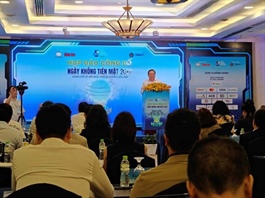Lenders utilise tiered interest rate incentives
Lenders utilise tiered interest rate incentives
Amid persistently low deposit interest rates, banks are flexibly implementing policies or applying tiered interest rate structures to attract deposit inflows.

Lenders utilise tiered interest rate incentives, Photo: Le Toan |
Currently, tiered interest rates have become prevalent and are applied by many banks such as Techcombank, VPBank, OCB, ACB, and more. These incentives are not only applicable to regular individual customers but also extend to priority customer segments, ranging from the middle class to private banking clients.
Representatives from commercial banks say that the orientation and objectives for capital mobilisation this year are to maintain stable and reasonable interest rate levels, aligned with capital utilisation plans and healthy credit growth.
Le Quang Vinh, CEO of Vietcombank, stated that since early 2023, the bank’s listed deposit interest rates have only been adjusted downward.
“Currently, Vietcombank’s deposit interest rates are the lowest in the market. This also creates pressure on Vietcombank’s capital mobilisation. However, in implementing the government’s directive on stabilising interest rates, the bank strictly adheres to State Bank of Vietnam (SBV) regulations on interest rates,” he added. “Vietcombank fully agrees with continuing to implement common interest rate levels to ensure stable monetary policy and support economic development.”
Techcombank is currently applying a policy of adding up to 0.5 per cent per annum to the first deposit in 2025 if customers choose terms of 3, 6, or 12 months.
According to the online interest rate schedule as of May 28 at Techcombank, customers opening new accounts with amounts under $40,000, after adding 0.5 per cent per annum, will receive the interest rates increase to 4.05, 5.05, and 5.25 per cent per annum for 3, 6 and 12-month terms.
Notably, for deposits of $120,000 or more, the interest rate can reach 5.35 per cent per annum for the 12-month term.
Deputy CEO at Techcombank Pham Quang Thang noted that during the recent period, Techcombank has maintained stable lending interest rates, gradually implementing solutions to reduce input and operational costs to offer customers better lending rates.
“Regarding deposit interest rate policies, deposits with terms over six months typically account for a small proportion of total mobilised capital. Recently, the bank adjusted interest rates downward for the 1-month and 3-month terms by 0.2 per cent and 0.1 per cent, respectively.”
Conversely, the bank made a slight increase of 0.1 per cent for the 6-month term to strengthen longer-term, more stable capital to better support business lending. Overall, the bank’s average deposit interest rate has decreased, thereby reducing input costs and providing a basis for lowering lending interest rates, added Thang.
At SeABank, customers making online savings deposits of $4,000 or more also receive an additional interest rate of up to 0.5 per cent per annum for 6-month, 12-month, and 13-month terms. After adding the bonus, the actual interest rates can reach 4.45 and 5.2 per cent per annum, respectively.
VPBank, one of the banks that reduced deposit interest rates twice in May, still maintains flexible bonus interest rate policies for various customer segments. For the private segment, customers making savings deposits with terms of one month or more receive an additional 0.1 per cent per annum for deposits from $4,000-20,000, and an additional 0.3 per cent per annum for deposits of $20,000 or more.
Additionally, VPBank’s priority customer segment enjoys similar incentives for deposits of $4,000 or more with a minimum term of one month. For the middle-class customer group, potential customers depositing from $2,000 or more have the bonus ranges from 0.03 to 0.08 per cent per annum, depending on the customer tier.
These bonus interest rate policies enable some customers to access actual savings interest rates exceeding 5.5 per cent per annum, even as the basic interest rate level has significantly declined.
According to information on interest rate developments from credit institutions in April, published by the SBV on May 22, the average lending interest rate for new loans at commercial banks in April ranged from 6.6-8.9 per cent per annum, slightly down from 6.6-9 per cent in March.
Specifically, short-term VND lending interest rates for priority sectors such as manufacturing, exports, agriculture, and social housing are currently as much as 3.9 per cent per annum, lower than the SBV’s prescribed ceiling of 4 per cent.
Alongside lending interest rates, deposit interest rates continue to trend downward. Deposit interest rates for terms of 6-12 months commonly range from 4.5-5.5 per cent per annum, while terms of 12-24 months fluctuate between 4.8-6 per cent per annum.
Facing increased capital demand, some small and medium-sized banks have adjusted deposit interest rates upward in April and May. Meanwhile, lending interest rates have not fluctuated significantly, indicating that the room for reducing deposit interest rates has narrowed considerably.
- 10:29 06/06/2025




























